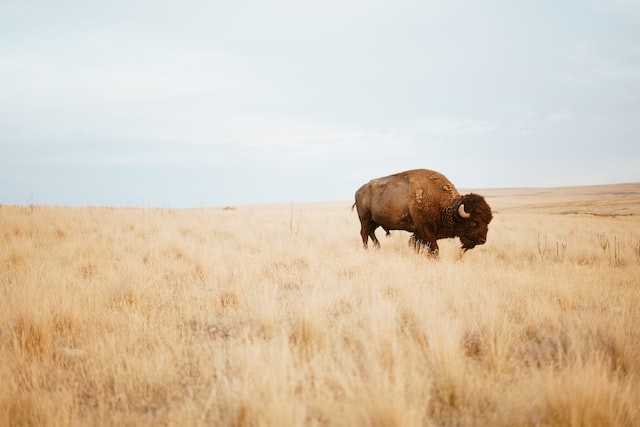Research performed by Kansas State University discovered that restoring bison, a once dominating grazer, increases plant variety in a tallgrass prairie.
The study, which included more than 30 years of data from the Konza Prairie Biological Station, was just published in the journal Proceedings of the National Academy of Science, or PNAS.
Reintroducing bison to grasslands
 (Photo : Bryce olsen/Unsplash)
(Photo : Bryce olsen/Unsplash)

The research was conducted in the Flint Hills ecoregion, which contains the largest remaining tallgrass prairie landscape, as per ScienceDaily.
Researchers looked at plant community composition and variety in three treatments meant to mimic typical management regimes: no mega-grazers, bison restored and permitted to graze year-round, or domestic cattle imported and allowed to graze during the growing season.
Bison were an important feature of North American grasslands until being eradicated from over 99% of the Great Plains, according to the main researcher Zak Ratajczak, an assistant professor of biology.
Because the elimination of bison happened prior to quantitative records, the implications of their removal are mostly unclear.
According to Ratajczak's findings, many grasslands in the central Great Plains have far lower plant richness than would have happened before bison were extensively wiped off.
Returning or "rewilding" native megafauna may aid in the restoration of grassland biodiversity.
Researchers set out to discover how bison impacted plant community resilience to climatic extremes in addition to addressing land use.
The scientists were able to record one of the most intense drought occurrences to occur in the Great Plains since the Dust Bowl of the 1930s due to the study's extended duration.
They discovered that after the climate extreme, native plant species in the bison-grazed area were drought resistant.
According to Ratajczak, the resilience found in bison grasslands is consistent with the idea that diversity promotes ecological resilience. And if our climate grows harsher, this resilience will become even more crucial.
Jesse Nippert, professor; John Blair, university distinguished professor; Allison Louthan, assistant professor; and Jeffrey Taylor, research assistant, all from the Division of Biology at the College of Arts and Sciences, were also involved in the study.
Scott Collins of the University of New Mexico, Sally Koerner of the University of North Carolina, and Melinda Smith of Colorado State University are also involved.
Some of the most important ecological patterns take decades to emerge, and scientists can only identify them with long-term records like those provided by the NSF LTER program, according to Nippert.
Fundamental features of ecosystems may go overlooked if only short-term tests are used.
Also Read: Bison: National Mammal, Says Senate
Benefits of bison to grassland
Approximately 150 years ago, over 30 million bison roamed the Great Plains until a widespread slaughter began in the early 1800s. By the late 1880s, there were just around 1,000 bison left, as per Defenders.
Bison, a keystone species, contribute to the habitat of many other species on the Great Plains, including grassland birds and even numerous plant species.
Bison forage by aerating the soil with their hooves, which aids plant growth, and dispersing native seeds, which helps to maintain a healthy and balanced ecosystem.
Over the last decade, the conservation community has made substantial contributions to bison conservation, assisting in the reintroduction of America's national mammal.
The bison is considered ecologically extinct because there are no longer millions of animals migrating across the plains, but conservation herds of 1,000 or more bison are being established to create a metapopulation, allowing the species to once again play an important ecological role on our prairie grasslands.
Almost extinct
It was not always assured that bison would be able to recover. They once numbered in the tens of millions and dominated the Great Plains landscape until the late 1800s, anchoring a remarkable ecosystem with possibly the highest concentration of mammals on the planet, as per The Conversation.
That abundance vanished when settlers and the US government waged a ruthlessly effective effort to eliminate the environment and the indigenous civilizations that relied on it.
Millions of bison were slaughtered, sometimes for "fun," sometimes for profit, and eventually to deprive Native Americans of crucial resources.
By 1890, there were less than 1,000 bison remaining, and their future seemed gloomy. There were just two tiny wild populations left in Yellowstone National Park and northern Alberta, Canada.
Related article: Genetically Pure Bison Still Exist; Provide Stronghold For Conservation
© 2024 NatureWorldNews.com All rights reserved. Do not reproduce without permission.





